|
|
|
Sort Order |
|
|
|
Items / Page
|
|
|
|
|
|
|
| Srl | Item |
| 1 |
ID:
135071


|
|
|
|
|
| Summary/Abstract |
Over the last 30 years, China has experienced tremendous growth, with many commentators attributing the rapid development to the ‘China Model’ (CM) or the ‘Beijing Consensus’ (BC). However, in recent years growth has slowed and an ever-increasing number of bears are predicting a financial crisis, economic collapse, and a very hard landing, perhaps even a lost decade a la Japan. All of this has led to heated debate about whether the CM is now exhausted, whether China is caught in ‘the middle-income trap’ (MIT) and whether a new model is needed for the next phase of development where China attempts the difficult transition from middle-income country to high-income country status. This article addresses the following five sets of issues. First, is there a CM or BC? If so, what does it entail, and does it differ from the model followed by other successful countries in East Asia? Second, is there a MIT? Is China stuck in the MIT or perhaps multiple MITs? Third, what adjustments to the economic model are required for China to continue its long march toward becoming a high-income country? Fourth, are political, legal and social reforms also required? If so, will all reforms proceed simultaneously or are reforms likely to be sequenced, with adjustments to the economy preceding reforms in other areas? Fifth, is there now a global convergence on a new model of development for developing countries – a Post-Washington, Post-Beijing Consensus?
|
|
|
|
|
|
|
|
|
|
|
|
|
|
|
|
| 2 |
ID:
103620
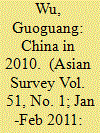

|
|
|
|
|
| Publication |
2011.
|
| Summary/Abstract |
China in 2010 followed two divergent tracks: one pursued continued high-speed economic growth while the other witnessed an ongoing rise of social discontent. Both confirmed the failure of government efforts to promote so-called "scientific," or balanced, development. Political disillusion over the "China model" surfaced; China's diplomacy saw many setbacks.
|
|
|
|
|
|
|
|
|
|
|
|
|
|
|
|
| 3 |
ID:
095536
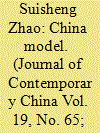

|
|
|
|
|
| Publication |
2010.
|
| Summary/Abstract |
China's economic success under an authoritarian political system in the past 30 years has raised a question about whether the China model will replace the Western model of modernization. This paper seeks answers to this question by exploring to what extent China offers a distinctive model of economic and political development and whether the China model represents a successful co-existence of a free market and an authoritarian state in order to maintain economic growth and political stability, as well as discussing what the appeals and limitations of the China model are.
|
|
|
|
|
|
|
|
|
|
|
|
|
|
|
|
| 4 |
ID:
108411
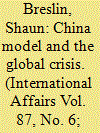

|
|
|
|
|
| Publication |
2011.
|
| Summary/Abstract |
The global financial crisis reinvigorated ongoing debates over whether China has its own distinct and separate 'model' of political economy and/or development. There is much that connects this Chinese model with previous systems of national political economies; partly in terms of specific policy preferences, but also in terms of shared basic conceptions of the distribution of power in the global order. Like these previous systems, China has come to stand as an example of an alternative to following dominant (neo-)liberal models of development. In this respect, what the China model is not and what China does not stand for might be more important than what it actually is and what it does stand for. However, the idea of a coherent and unique Chinese model has considerable purchase, and is both informed by and also feeds into considerations of China's uniqueness and difference from the norms, ideas and philosophies that dominate the rest of the world.
|
|
|
|
|
|
|
|
|
|
|
|
|
|
|
|
| 5 |
ID:
094694
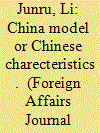

|
|
|
| 6 |
ID:
154165
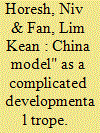

|
|
|
|
|
| Summary/Abstract |
This article complicates existing portrayals of the China developmental "'model" from two angles. First, it problematises the historical basis of what many in the advanced "First World", particularly in America, used to see as their superior model of governance. In the final analysis, the current enthusiasm in these countries about the "China model" may have nothing to do with China per se but more to do with the decline of self-celebrated Western models that are themselves ideal-typical abstractions. Second, upon re-examining its historical record, it posits the alternative "China model" as similarly problematic. Triumphant portrayals of Chinese exceptionalism by China-based scholars have been predicated on a troubled Mao-era legacy, the implications of which remain unclear for understanding the increasingly fragmented and globally involved Chinese economy. Building on this double complication, the article concludes with a call for more historically grounded and geographically variegated examinations of Chinese political-economic evolution.
|
|
|
|
|
|
|
|
|
|
|
|
|
|
|
|
| 7 |
ID:
151412
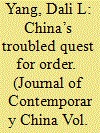

|
|
|
|
|
| Summary/Abstract |
China’s pursuit of rapid growth has gone hand-in-hand with the development and elaboration of a stability maintenance regime. If there is a China model, then a key element of that model is the stability maintenance regime. This article traces the origins and evolution of the multiple institutions that make up this regime and reveals a confluence of technocratic leadership and organizational factors that have shaped the character and dynamics of this regime, including its intensification in the 2000s.
As successive leaders of the regime have turned to seemingly rigorous mechanisms of measurement, discipline and control to curb petitions, reduce crime or improve court efficiency, all in the name of preserving stability, they also sowed the seeds of various forms of excesses. There have been efforts to address some of the most glaring abuses in recent years but the regime continues in the era of Xi Jinping, torn between a strong preoccupation with stability and a desire to promote law-based governance.
|
|
|
|
|
|
|
|
|
|
|
|
|
|
|
|
| 8 |
ID:
100256
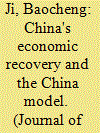

|
|
|
|
|
| Publication |
2010.
|
| Summary/Abstract |
Starting with the US subprime crisis, the world has fallen into the most severe economic crisis since the Great Depression. Unlike other major nations, China was the first to recover from the economic downturn. Researchers and policymakers have begun to wonder if China could actually bring the world out of the financial crisis. This paper intends to contribute to the discussion relating China's outstanding economic performance with reference to the 'China model'. China has recently managed to escape from the world economic recession and demonstrated a strong tendency for full recovery. The core reason lies in the fact that the Chinese system is characterized with a unique mechanism of resource allocation, and a macroeconomic decision-making process functions as a powerful and effective instrument with regard to crisis management. Moreover, the existence of state enterprises that are compatible with a market-oriented economy has played an important role in stimulating economic activity.
|
|
|
|
|
|
|
|
|
|
|
|
|
|
|
|
| 9 |
ID:
116495


|
|
|
|
|
| Publication |
2012.
|
| Summary/Abstract |
Drawing on the fast growing literature concerning Chinese development and transition, we sketch a general framework for understanding the 'China Miracle' that the 'conventional wisdom' and 'Washington Consensus' cannot fully explain. Reflecting upon the recent financial crisis and the subsequent worldwide economic downturn, an attempt is made to present a paradigm, inspired by Chinese practice over the past decades, from a historical perspective. We conjecture that a desirable China model may maintain the characteristics of a good economy as proposed in Phelps (2006) with full employment and rights to personal development. With regard to the functioning of freely competitive markets and macroeconomic policy, not only should a China model be able to mimic the rule of law and accountability of liberal western democracies, but it might also possess a mainstream ideology that is deeply rooted in Chinese culture with modern social sciences as theoretical foundations. To divest China of undesirable properties from the existing system, it is necessary to establish a principle-agent relationship that can provide stable governance structure for day-to-day efficient management of the economy and society, and protect the fundamental interests of its citizens when external challenges threaten to weaken social cohesion and political stability.
|
|
|
|
|
|
|
|
|
|
|
|
|
|
|
|
| 10 |
ID:
174780
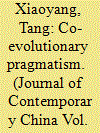

|
|
|
|
|
| Summary/Abstract |
There is a gap between the elusive concept of Beijing Consensus and China’s effective practices to promote economic growth at home and in other countries. This article aims to expound this phenomenon by examining both the rationale underlying China’s structural transformation and the corresponding practices in development cooperation. Using a case study on the evolution of infrastructure construction within China and abroad, this article argues that China's success has little to do with a new pattern of state capitalism, but rather presents a different manner of understanding and facilitating modernization. Target-oriented non-linear synergism can drive comprehensive transformation more effectively in developing countries than model-oriented linear mechanism. With a consistent goal, the pragmatic thinking enables multiple stakeholders to coevolve in diverse contexts through open attitude.
|
|
|
|
|
|
|
|
|
|
|
|
|
|
|
|
| 11 |
ID:
174867
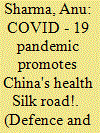

|
|
|
| 12 |
ID:
131820
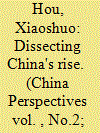

|
|
|
|
|
| Publication |
2014.
|
| Summary/Abstract |
The recent discussion of a "Beijing Consensus" and a China model seems to challenge neoliberalism as the dominating discourse on development. This paper attempts to explain the contradictions in China's development and discusses whether and how they can be redressed. Specifically, the paper analyses the key issues around the debate over the China model - how distinctive it is and whether it can be replicated elsewhere, and what real lessons can be drawn from China's rise. It proposes a more nuanced view of the economic, social, and political structures in China with a focus on its mixed economy, the role of the state at both the central and local levels, and the possibility of Chinese-style democracy. It also offers suggestions for improving the China model.
|
|
|
|
|
|
|
|
|
|
|
|
|
|
|
|
| 13 |
ID:
158386
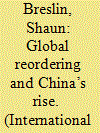

|
|
|
|
|
| Summary/Abstract |
While much of the debate over the implications of China’s rise tends to dichotomise around either status quo or revisionist predictions, the reality seems to lie somewhere in between. In broad terms, China has embraced multilateral forms of cooperation and governance. This does not mean, however, that it is satisfied with the distribution of power in many international institutions, or some of the norms and principles that underpin them. This has resulted in a reformist position, with China increasingly willing to offer its own supplementary alternatives. China’s rise has also provided an important economic alternative to dealing with the West, and considerably undermined the ability of others to establish their preferences and world views. China’s lack of commitment to democracy and the external promotion of human rights remains a key reason why some analysts remain unconvinced about the long-term ambitions of an illiberal actor in a global liberal order.
|
|
|
|
|
|
|
|
|
|
|
|
|
|
|
|
| 14 |
ID:
123102
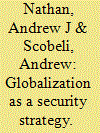

|
|
|
|
|
| Publication |
2013.
|
| Summary/Abstract |
Andrew J. Nathan AND Andrew Scobell analyze the gains and losses to Chinese security from the country's embrace of globalization in the post-Mao period. They argue that while China has grown richer and more influential, it has also been penetrated by global forces that it does not control and enmeshed in complex relationships of interdependence.
|
|
|
|
|
|
|
|
|
|
|
|
|
|
|
|
| 15 |
ID:
148138
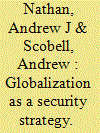

|
|
|
|
|
| Summary/Abstract |
ANDREW J. NATHAN and ANDREW SCOBELL analyze the gains and losses to Chinese security from the country’s embrace of globalization in the post-Mao period. They argue that while China has grown richer and more influential, it has also been penetrated by global forces that it does not control and become enmeshed in complex relationships of interdependence.
|
|
|
|
|
|
|
|
|
|
|
|
|
|
|
|
| 16 |
ID:
114668
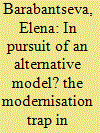

|
|
|
|
|
| Publication |
2012.
|
| Summary/Abstract |
This article contributes to the debates on China's socio-political transformations by tracing the link between China's modernization and nationalism, and
analysing their mutual interplay. Many recent studies discuss post-Mao China's
development as a unique model challenging earlier development approaches. Instead,
the argument pursued here points to the dependence of China's dominant development
thinking on the paradigm of modernization and its symbolic celebration in official
discourse and public rituals. By tracing the impact of the modernization paradigm in
the influential annual publication China Modernization Report and in the 2009
National Day mass parade, the article shows how and what kind of Chinese nation is
produced. I argue that China's ostensibly unique development model is constrained by
the modernization thinking underlying it. Analysis of the discourses on modernity and
'scientific development' and the symbolism associated with them reveals a series of
dichotomies and oppositions underpinning China's nation-building. China's pursuit of
modernization relies on the suppression of other possible development paths within
China and subsumes Chinese development experiences under those of the generalised
West, thereby restricting development alternatives to those allowed within a
hierarchical view of the world.
|
|
|
|
|
|
|
|
|
|
|
|
|
|
|
|
| 17 |
ID:
124991
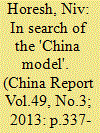

|
|
|
|
|
| Publication |
2013.
|
| Summary/Abstract |
The 'China Model' literature in English was until recently quite peripheral and rather ahistoric in nature. It was mainly penned by economists and other social scientist who aimed at generalising how China's reforms worked since 1978. Historians, to the extent they tried at all to find linkages between Deng Xiaoping's reforms and China's pre-1978 heritage, were rather minimalistic in their approach. And since many economists reduced China's achievements to the inflow of foreign investment in pursuit of cheap labour and tax breaks, many historians also tended to view the Special Economic Zones set up by Deng as merely reincarnations of a well-tried formula whereby Westerners were allowed to set up autonomous and bustling treaty ports along the China coast in the later part of the 19th century. In short, it was often suggested that the reforms the PRC had embarked on in 1979 were not so boldly original or ingenious as might be otherwise assumed. Yet, because PRC social scientists in their advisory capacity are more tightly linked with government than in the West, one can freely come across in the Chinese literature very sober and historicised academic accounts of the challenges the country is facing domestically and internationally, so long as the Party's monopoly on power is not challenged directly. The following passages address an important book in that vein by prominent Tsinghua University professor, Yan Xuetong, that was recently translated into English. It is not a monograph in the strict sense of the word, but makes for a compilation of articles from various stages of the author's career. Thus, Yan's book offers stimulating insights on how China's pre-modern past might inform the nature Chinese ambitions for global leadership in the future
|
|
|
|
|
|
|
|
|
|
|
|
|
|
|
|
| 18 |
ID:
192619
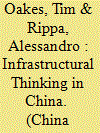

|
|
|
|
|
| Summary/Abstract |
Despite China's leading role in the construction of infrastructure over the past decades, the most influential paradigms for the study of infrastructure in the social sciences originate from research conducted elsewhere. This introduction to the special section “Chinese Infrastructure: Techno-politics, Materialities, Legacies” seeks to address this apparent gap, and contributes to building an innovative research agenda for an infrastructural approach in the China studies field. To do so, it pushes forward an understanding of infrastructure as both an empirically rich material object of research and an analytical strategy for framing research questions. We draw from two strands of inquiry: recent efforts to rethink the materiality of infrastructures not as an inert or stable basis upon which more dynamic social processes emerge, but rather as unstable assemblages of human and non-human agencies; and scholarship that explores the often hidden (techno-)political dimensions of infrastructures, through which certain intended and unintended outcomes emerge less from the realms of policy and implementation and more from the material dispositions and effects of infrastructural formations. These strands of inquiry are brought together as part of our effort to recognize that the infrastructural basis of China's approach to development and statecraft deserves a more concerted theorizing of infrastructure than we have seen thus far.
|
|
|
|
|
|
|
|
|
|
|
|
|
|
|
|
| 19 |
ID:
112518


|
|
|
|
|
| Publication |
2011.
|
| Summary/Abstract |
Vietnam and China have had along, if not always amicable, historical relationship. This relationship continued to be important even as Vietnam began its transition from a command economy to greater market orientation using the same strategy of pragmatic gradualism adopted by China when the latter began its own transition a decade before. As this strategy appears now to have lost momentum following the onset of the 2008 global financial crisis, Vietnam's economic planners, preparing the country's Socioeconomic Development Strategy for the new decade (2011-2020), have proposed new initiatives to achieve sustained growth. China's successful experiments, specifically with enterprise groups, special economic zones, and technology and industrial policies, again loom large among these proposed initiatives. To be successful, however, Vietnamese planners will need to be aware of the particular circumstances that favored China's experiments, to draw lessons from China's successes and failures, and to overcome the major challenges that Vietnam especially faces, These include, in comparison with China, a less competitive state enterprise sector; weaker implementation capacity at the subnational level, and pervasive corruption.
|
|
|
|
|
|
|
|
|
|
|
|
|
|
|
|
| 20 |
ID:
151413


|
|
|
|
|
| Summary/Abstract |
This article proposes that advocates of the China model deploy notions of culture and tradition in ways that hide the central role of militarism in Chinese politics. The hypothesis is explored by looking at the ways in which the country’s military and paramilitary institutions are used to propagate militaristic values and practices through the policies of National Defense Education (NDE) and National Defense Mobilization (NDM). This yields evidence from policy documents, the discussions of educationalists and the content of teaching materials. The conclusion is that focusing on the role of militarism provides better insights into the way that social stability and political continuity are maintained than resorting to vague notions of ‘culture’ and ‘tradition’ in the China model.
|
|
|
|
|
|
|
|
|
|
|
|
|
|
|
|
|
|
|
|
|